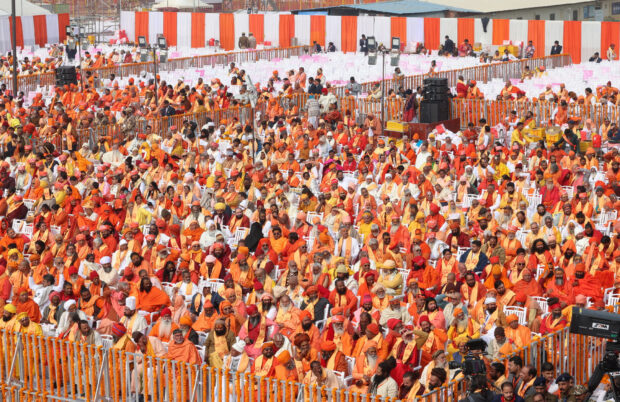Temple tourism set to soar under India’s Modi

Hindu saints attend the opening of the grand temple of the Hindu god Lord Ram in Ayodhya, India, January 22, 2024. India’s Press Information Bureau/Handout via REUTERS
NEW DELHI — Indian Prime Minister Narendra Modi on Monday inaugurated one of the holiest Hindu temples and his government has been spending millions of dollars to develop many others, boosting tourism and his appeal among the majority community ahead of elections.
Apart from a $6 billion makeover of the northern city of Ayodhya, where Modi opened the first phase of a Ram Temple, the federal government has spent nearly $120 million to develop dozens of Hindu pilgrimage sites in the past decade, according to government data, and more funding is planned.
The Ram Temple, built on the site of a Mughal-era mosque that was razed by a Hindu mob in 1992 and where Hindus believe Lord Ram was born, is estimated to draw up to 100 million tourists a year, according to Jefferies analysts. In comparison, about 9 million people visit Vatican City in a year and about 20 million Mecca.
READ: Indian devotees splurge on jets, gold idols as Hindu temple opens
“The creation of a new religious tourist centre (Ayodhya) with improved connectivity and infrastructure can create a meaningfully large economic impact,” the analysts wrote in a note.
Since Modi inaugurated the Hindu pilgrimage site of Kashi Vishwanath Corridor on the banks of the Ganges in 2021 in his constituency of Varanasi, more than 130 million tourists have visited the area, according to government data.
Article continues after this advertisementThe yearly footfall in Varanasi, which like Ayodhya is in India’s most populous state of Uttar Pradesh and is one of the oldest living cities in the world, was barely 7 million before that.
Article continues after this advertisementAnalysts say tourism income for locals and hotels in Varanasi – by dying where Hindus believe to attain salvation and freedom from the cycle of birth and re-birth – have surged by up to 65%.
With nearly $200 billion in revenue, tourism contributes about 7% of India’s economy, which is below most large emerging and developed economies by up to 5 percentage points.
The new temple and renovations of many others are likely to greatly boost the electoral prospects of the Hindu nationalist party of Modi, who is widely expected to win a rare third straight term in general elections due by May. Monday’s inauguration fulfilled a decades-old election pledge of Modi’s Bharatiya Janata Party (BJP).
“With today’s event, definitely the momentum is with the BJP,” political commentator Sandeep Shastri. “It may be fair to say that any political party would like to make the best of a situation they find themselves in, and the BJP seems to have mastered the art of managing the message.”
Out of the 46 projects funded under the Ministry of Tourism’s “Pilgrimage Rejuvenation and Spiritual Heritage Augmentation Drive” since Modi came to power in 2014, only about half a dozen are Muslim or Sikh sites. Muslims account for about 14% of India’s population of 1.42 billion, most of them Hindus.